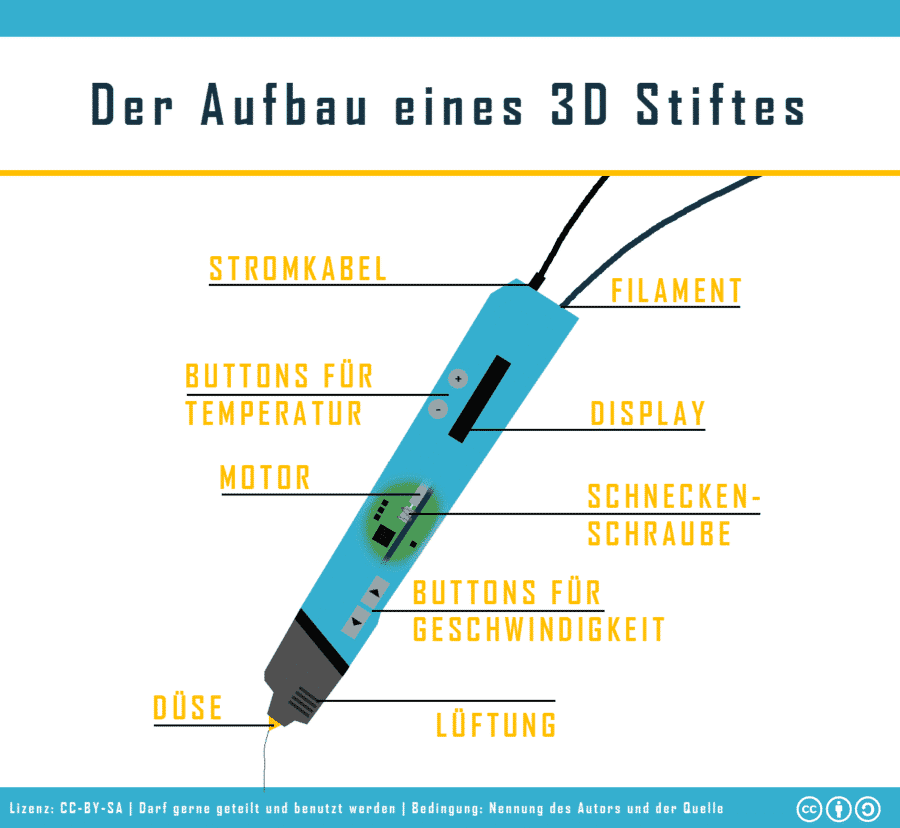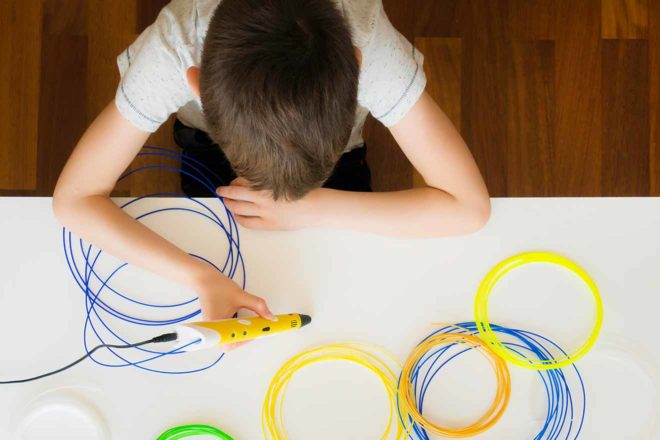3D Pen – What is it anyway?
In this article you will learn about 3D pens. We will show you what a 3D pen is, how it is built and why a 3D pen can enrich our lives. You will also get to know the bestsellers among the 3D pens.
The best 3D pens 2024
There are new suppliers and different models of 3D pens almost every day. Learn what to look for when buying a 3D pen in the article“Buying a 3D Pen – What to Look for?“
What is a 3D pen?
A 3D pen is a cross between a 3D printer and a hot glue gun. While with a hot glue gun you just heat it up and hope nothing drips when you press it, with a 3D pen you have almost complete control over temperature and speed. That is, you can use multiple materials and, depending on your skill level, literally push the envelope.
Keep in mind, however, that many manufacturers do not recommend the use of flexible material and filament with wood or other specialty materials. The nozzle can clog relatively quickly and with a 3D pen, cleaning is possible in many cases, but it's not very fun due to the way it's built.
How is a 3D pen constructed?
The most important parts of a 3D pen are clearly shown in the following figure:

Since electrical power is required for the use of a 3D pen, each 3D pen has a power connector at the top end to which a power cable is connected. Depending on the design, these can be the following cable types:
- The cable of the power supply, which provides over 12 volts
- A USB cable with a proprietary connector to the 3D Pen. Since these cables are produced specifically for the respective 3D pens, you should take good care of them.
- A USB cable with a micro USB connector to the 3D Pen. You probably use a cable like this every day on a device in your household. Therefore, the cable can be quickly replaced if there are problems with the included 3D pen cable.
Also at the upper end of the 3D pen is the insert for the filament. Note that you need to cut the filament end straight so that your 3D pen can grip the material. Almost all 3D pens use filament with a diameter of 1.75 mm.
Most 3D pens have a display that shows you the current status about the activated mode (ABS/PLA or temperature 1/2/3 etc.). This facilitates the use of the 3D pens and thus increases the ease of use.
Also, many 3D pens have buttons for speed and temperature. For some, only predefined temperature levels can be selected. Still others offer you the possibility to adjust the temperature steplessly.
Inside the 3D pen are the electronics and the drive motor. In the case shown, this motor drives a worm screw. This screw must therefore “grab” the inserted material and push it towards the nozzle. If the die is too cold for the material, no material will be extruded. If the nozzle is hotter and has reached a temperature below the melting temperature of the material, you should wait before painting. This is due to the fact that the material is a little extruded in the best case. In the worst case, you can clog the nozzle with it.
Also almost all 3D pens offer a small ventilation. The is always arranged so that in normal use the hot air can not hit the user…,
Who started the 3D pen revolution?
The 3Doodler * is considered the father of the 3D printing pens available today. As is often the case, the idea was born out of frustration by two inventors, Peter Dilworth and Maxwell Bogue. They were not very happy after a 14 hour print run when they saw that the printer had skipped a shift. So they founded the company WobbleWorks and started developing the 3Doodler 3D pen. To invest the venture, they launched a Kickstarter campaign that raised $2.3 million in a very short time with a goal of $30,000. This great success naturally ensured that other companies adopted the idea to launch their own products.

What can 3D pens be used for?
The possible uses of 3D pens are almost endless. Of course, you can't expect accurate models like a “real” 3D printer, but that's not the claim of the pens. You can use it if you want to be artistically active and, for example, create “window pictures in 3D”, invent and implement decorative items or use it for repair purposes and for gluing 3D printed objects.
Get creative – use the pen for your art
With the strands that come out of the 3D pen, you can give free rein to your creativity. You are not tied to a heating bed and can use almost any surface to create your own object on it. With a little practice, you can also get it to “paint” in the air.
Decorative items – Made By Dir
If you love to decorate your house and always try to add your own touch to it, then 3D pens are surely for you. For example, you can use it to decorate various decorative items and show whose apartment or house the guests have just entered. Once you've created your ideas on a flat surface, all you have to do is warm them up to fit the shape of a vase or similar.
Helpful tool in connection with a 3D printer
That is more my field of application. I use my 3D pen mainly to repair failed prints or to join two printed objects together. Did you print out a figure and did an arm fall off? Then glue it back on – with the help of a 3D pen.
Why use a pen instead of a 3D printer?
I wouldn't say you should necessarily choose a pen over a 3D printer. But what you can do if you don't have a 3D printer yet: buy a 3D pen and play around with it. Just give it a try. Because then you'll get a feel for how much time 3D printing still takes. After all, if you can sit and create an object for 3 hours, you'll certainly be able to wait 14 hours for a printout.
Especially for children, a 3D pen is always very exciting and can attract them to our dear technology.
How is the filament inserted into the 3D pen?
Here there is a small, but still subtle difference to 3D printers themselves. Unlike them, a 3D pen requires the filament to be cut straight. This is due to the fact that a 3D pen is structured differently in terms of material guidance than a 3D printer. The straight cut allows the filament to be better “gripped” and guided to the hot nozzle (the so-called nozzle).
Should a manufacturer nevertheless expect a “slanted step”, this will also mark it out. This information will then also be available here as soon as the data shown above is updated.
3D pen stencils
If you don't want to just follow your own ideas, there is also the option to download pre-made 3D pen templates for free or for a small amount.
To go to the stencils page, click on the link below:
